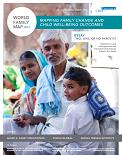Mapping Family Change and Child Wellbeing Outcomes
For the first time, data are available on family well-being across high and low income countries around the world. The World Family Map report summarizes a large body of data on family strengths and challenges, as well as important educational outcomes for children and youth. The report explores the social, economic, familial, and cultural factors that tend to strengthen or undermine family life.
Some of the findings include:
Family Structure
- Although two-parent families are becoming less common, they still constitute a majority of families around the globe. Children are most likely to live in two-parent families in Asia and the Middle East, and somewhat less likely to live in two-parent families in the Americas, Europe, Oceania, and sub-Saharan Africa.
- Extended families appear to be common in Asia, the Middle East, south America, and sub-Saharan Africa.
Family Socioeconomics
- The proportion of absolute poverty in the countries studied in the report ranges from zero percent in several countries to 64 percent in Nigeria. The proportion of relative poverty for children ranges from six percent (Netherlands) to 33 percent (Peru), with the lowest rates found in Asia, Europe, and Oceania, and the highest rates found in south America.
- The lowest levels of parental educational attainment are found in Africa, followed by Asia, the Middle East, and Central and South America. The highest levels are found in North America and Western Europe.
Family Processes
- Between six percent (South Korea) and 39 percent (Argentina) of 15-year-olds discuss political or social issues with their parents several times a week.
- The percentage of 15-year-olds who eat meals with their families regularly varies widely throughout the world, ranging from 62 percent in Israel to 94 percent in Italy and countries in Asia, the middle east, and sub-Saharan Africa leaning more towards rejection (as evidenced by an acceptance rate of only two percent in Egypt and Jordan).
Essay: Two, one or no parents? Children’s living arrangements and educational outcomes around the world
“Prior research—mostly on the US and Europe—suggests that children who grow up without one or both parents in the household are at risk for a host of negative educational outcomes. This essay builds on this research to explore whether this finding holds true in all regions of the world”
Read the full report here

